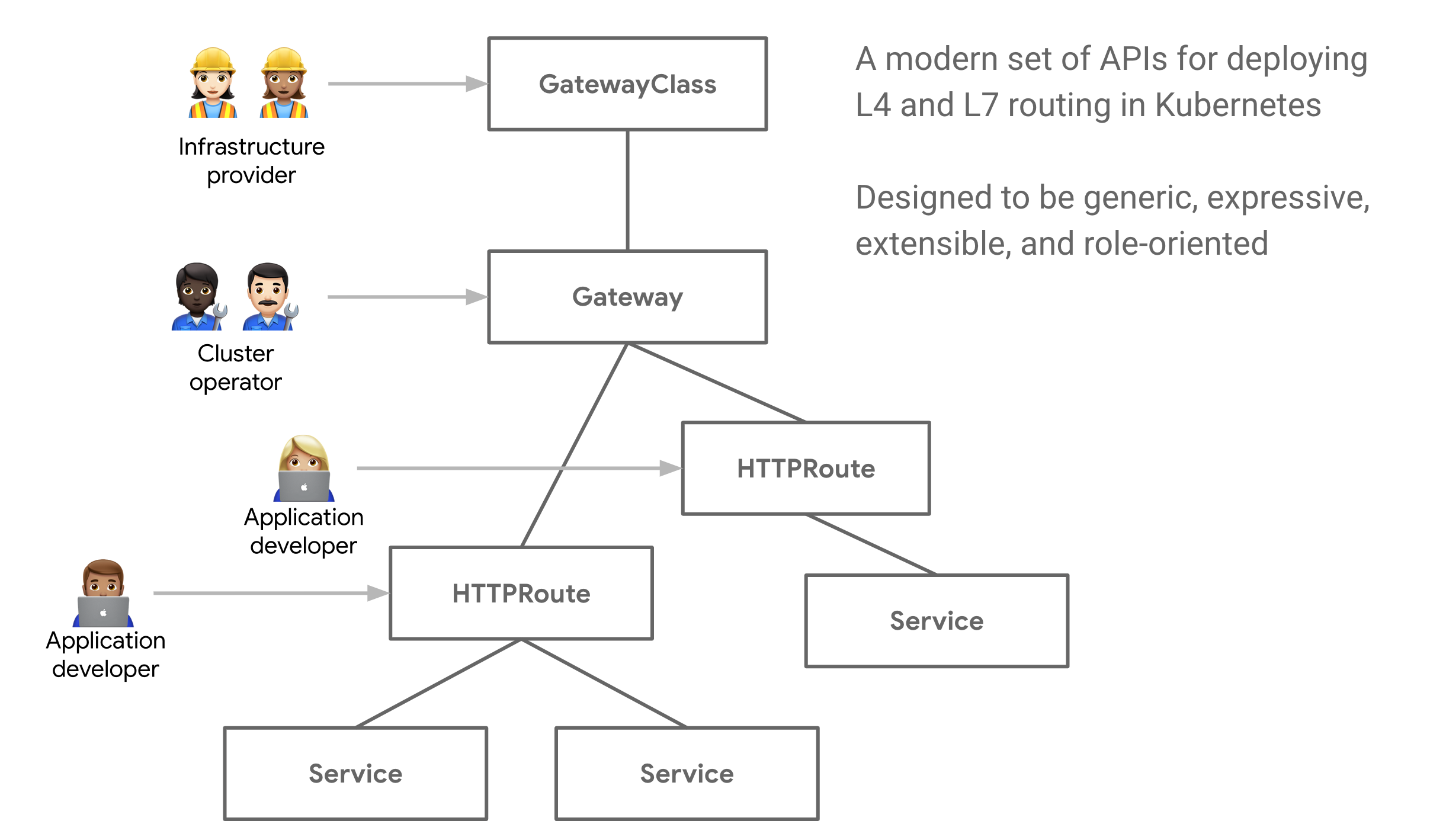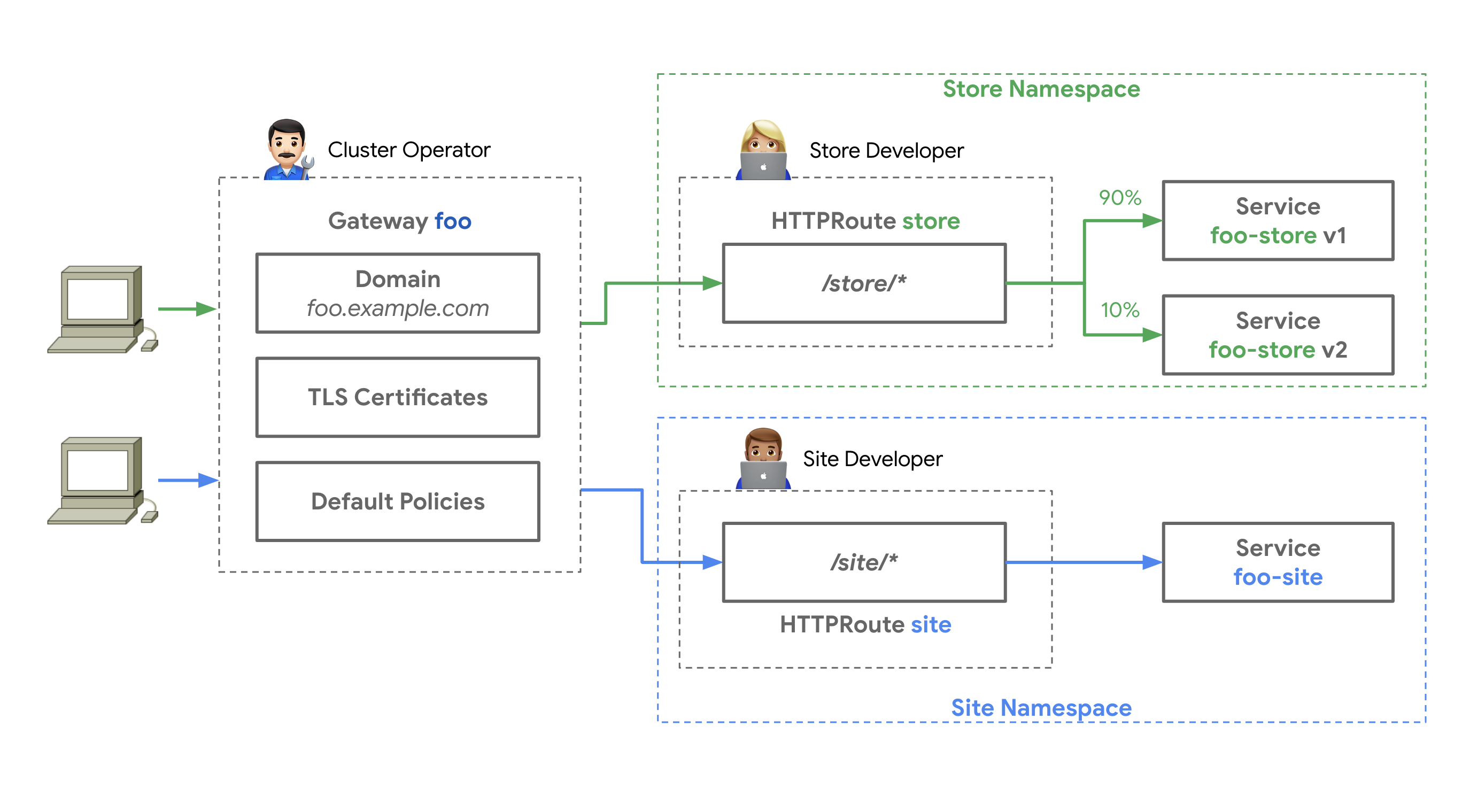Introduction
What is the Gateway API?¶
Gateway API is an open source project managed by the SIG-NETWORK
community. It is a collection of resources that model service networking
in Kubernetes. These resources - GatewayClass,Gateway, HTTPRoute,
TCPRoute, Service, etc - aim to evolve Kubernetes service networking through
expressive, extensible, and role-oriented interfaces that are implemented by
many vendors and have broad industry support.
Note: This project was previously named "Service APIs" until being renamed to "Gateway API" in February 2021.

Getting started¶
Whether you are a user interested in using the Gateway API or an implementer interested in conforming to the API, the following resources will help give you the necessary background:
- API overview
- User guides
- Gateway controller implementations
- API reference spec
- Community links and developer guide
Gateway API concepts¶
The following design goals drive the concepts of the Gateway API. These demonstrate how Gateway aims to improve upon current standards like Ingress.
- Role-oriented - Gateway is composed of API resources which model organizational roles that use and configure Kubernetes service networking.
- Portable - This isn't an improvement but rather something that should stay the same. Just as Ingress is a universal specification with numerous implementations, Gateway API is designed to be a portable specification supported by many implementations.
- Expressive - Gateway API resources support core functionality for things like header-based matching, traffic weighting, and other capabilities that were only possible in Ingress through custom annotations.
- Extensible - Gateway API allows for custom resources to be linked at various layers of the API. This makes granular customization possible at the appropriate places within the API structure.
Some other notable capabilities include:
- GatewayClasses - GatewayClasses formalize types of load balancing implementations. These classes make it easy and explicit for users to understand what kind of capabilities are available via the Kubernetes resource model.
- Shared Gateways and cross-Namespace support - They allow the sharing of load balancers and VIPs by permitting independent Route resources to bind to the same Gateway. This allows teams (even across Namespaces) to share infrastructure safely without direct coordination.
- Typed Routes and typed backends - The Gateway API supports typed Route resources and also different types of backends. This allows the API to be flexible in supporting various protocols (like HTTP and gRPC) and various backend targets (like Kubernetes Services, storage buckets, or functions).
Why does a role-oriented API matter?¶
Whether it’s roads, power, data centers, or Kubernetes clusters, infrastructure is built to be shared. However, shared infrastructure raises a common challenge - how to provide flexibility to users of the infrastructure while maintaining control by owners of the infrastructure?
The Gateway API accomplishes this through a role-oriented design for Kubernetes service networking that strikes a balance between distributed flexibility and centralized control. It allows shared network infrastructure (hardware load balancers, cloud networking, cluster-hosted proxies etc) to be used by many different and non-coordinating teams, all bound by the policies and constraints set by cluster operators. The following example shows how this works in practice.
A cluster operator creates a Gateway resource derived from a GatewayClass. This Gateway deploys or configures the underlying network resources that it represents. Through Route binding policy set on the Gateway, the operator permits (or denies) specific teams to bind to this Gateway and expose their applications through it. Centralized policies such as TLS can be enforced on the Gateway by the cluster operator. Meanwhile, the store and site teams run in their own Namespaces, but bind their Routes against the same shared Gateway, allowing them to independently control their routing logic. This separation of concerns allows the store team to manage their own traffic splitting rollout while leaving centralized policies and control to the cluster operators.

This flexibility allows the API to adapt to different vastly different organizational models and implementations while remaining a portable and standard API.
Who is working on Gateway?¶
The Gateway API is a SIG-Network project being built to improve and standardize service networking in Kubernetes. Current and in-progress implementations include Contour, Emissary-Ingress (Abassador API Gateway), Google Kubernetes Engine (GKE), Istio, Kong, and Traefik. Check out the implementations reference to see the latest projects & products that support Gateway. If you are interested in contributing to or building an implementation using the Gateway API then don’t hesitate to get involved!